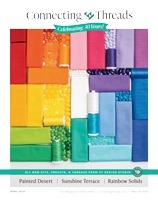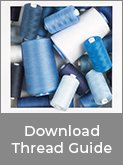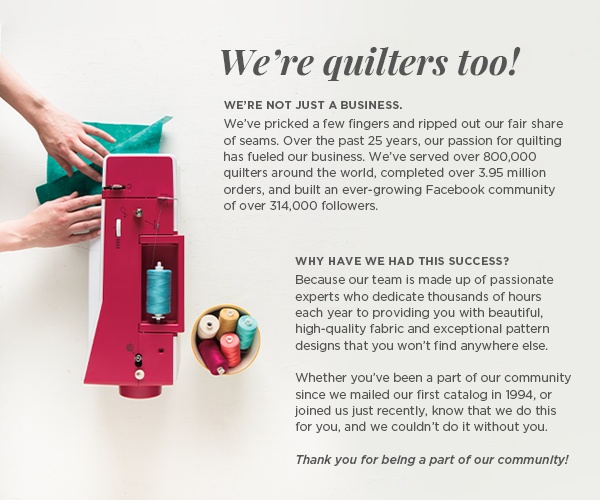Glossary of Terms
Fabric Cuts
Charms |
5” square of fabric, usually sold in packs that include one of every fabric in a collection, or a group of coordinating fabrics. |
|
Collection |
A group of fabrics designed to work together |
|
Custom Cuts |
Fabric that is not pre-cut, instead it is cut to your preferences. At Connecting Threads, we cut any length in quarter yard increments, including fat quarters. |
|
Fat Eighth |
Half of a Fat Quarter, usually 18” x 11” |
|
Fat Quarter |
One quarter yard of fabric, but cut to be more usable for quilters – measures approx 22” x 18”. Fat quarters are cut by starting with one half yard, cutting it in half. |
|
Strips of fabric that measure 2 ½” x width of fabric, usually sold in packs that include one of every fabric in a collection, or a group of coordinating fabrics. Also known as Strips |
|
|
Generally a kit includes all of the fabrics you need complete a quilt top or project, often including the pattern. This varies widely depending on where you purchase a kit, so read the contents carefully. |
|
|
10” square of fabric, usually sold in packs that include one of every fabric in a collection, or a group of coordinating fabrics. |
|
|
Linear |
Refers to the way the fabric is cut from a bolt. A linear cut is the width of fabric x the measurement. For example, a ¼ yard linear cut is 9” x width of fabric |
|
Pre-cuts |
A pre-measured cut of fabric, such as a Fat Quarter or Charm sampler, usually sold in packs that include one of every fabric in a collection, or a group of coordinating fabrics. Generally, every fabric in a pre-cut pack is the same cut. |
|
A group of fabrics that either coordinate or are from the same collection. |
|
|
10” square of fabric, usually sold in packs that include one of every fabric in a collection, or a group of coordinating fabrics. |
|
|
Strips of fabric that measure 2 ½” x width of fabric, usually sold in packs that include one of every fabric in a collection, or a group of coordinating fabrics. Also known as Jelly Rolls. |
Acronyms
| FQ |
Fat quarter |
|
HST |
Half square triangle |
|
LA |
Long Arm (quilter) |
|
PIGS |
Projects in grocery sacks |
|
RST |
Right sides together |
|
UFO |
Unfinished object |
|
WIP |
Work in progress |
|
WOF |
Width of fabric |
|
WOFQ |
Width of fat quarter |
|
WST |
Wrong sides together |
Sewing and Quilting Terms
|
Backing |
The back layer of a quilt that covers the middle batting section. Also see Quilt Sandwich. A backing could be a single piece of fabric, or pieced into a unique design. |
|
Basting |
Very large stitching used to temporarily hold fabric layers together. Could be machine or hand basted. |
|
The middle layer of a Quilt Sandwich, intended to provide warmth to the finished quilt. Can be made from cotton, wool, polyester, bamboo, silk, or a blend of any of these. |
|
|
Bias |
The diagonal of fabric is known as bias. Strips cut from the bias of fabric are extremely stretchy with plenty of “give.” Excellent for appliquéd stems, binding, etc. |
|
Binding |
The finishing touch on a quilt. After a quilt is quilted, a narrow piece of fabric is sewn all around the perimeter of the quilt, covering all raw edges and providing a protective layer at the edge. Binding can be made from bias, cross grain or straight of grain fabric. It can be one fabric, or many fabrics pieced together, end to end. It traditionally is double folded to provide extra strength around the edge, where a quilt often gets more wear and tear. |
|
Blanket Stitch |
Embroidery stitch done by hand or by machine that works well to finish an appliquéd edge. Also known as Buttonhole Stitch. |
|
Block |
One component of a quilt top, often the key focal of the design. A block is often a pieced design in a square or rectangle shape. |
|
Border |
The outer segment of a quilt top. A border is not required for a quilt, but is often used to frame the blocks and increase the size. |
|
Buttonhole Stitch |
Embroidery stitch done by hand or by machine that works well to finish an appliquéd edge. Also known as Blanket Stitch. |
|
Chain Piecing |
A time saving piecing technique where block components are sewn on to their blocks at the same time without cutting the threads. See our tutorial for Beginner Log Cabin blocks. |
|
Cornerstones |
Generally a small square piece of fabric used at the corner of blocks or sashing sections of a quilt top |
|
Cross grain |
Fabric as measured from selvage to selvage. Cross grain fabric has more natural stretch or “give” than straight of grain. |
|
A space to hang your or segments and preview the design before piecing them together. Can be as simple as a piece of flannel or batting tacked to a wall, or fancier purchased walls are available. |
|
|
Embellishment |
The addition of trims, buttons, thread, etc to the surface of a finished block, quilt or project. Could also be embroidery or appliqué. |
|
Embroidery |
Hand or machine stitching to create a unique design on top of a finished block, quilt or project. Is considered an embellishment. |
|
Feed Dogs |
The mechanism on a sewing machine that is under the plate and moves forward and backward when the sewing machine is engaged. This assists the fabric movement. |
|
Finished size |
This is the measurement of a block or quilt or section, after all of the seams are completely finished and no raw edges remain. |
|
Free motion |
Free form sewing that can be quilting or thread embellishment. Feed dogs are lowered, or dropped, on the sewing machine so the quilter is in control of where the fabric is moved. For accurate stitch length, the quilter then must achieve a balance of how fast the stitching goes vs how much the fabric is moved. |
|
Fusible Web |
A product that is applied with heat (like an iron) to fabric. Fabric bonded with fusible web is then used to embellish or appliqué projects. |
|
Fussy Cut |
To select a specific area of a motif when cutting fabric, instead of allowing random cuts. |
|
Label |
Usually placed on the back of a finished quilt, the label includes information such as who made it and when, who was the recipient, perhaps what is special about it. Especially important for dating heirloom quilts 100 years from now! Can be written in water soluble ink or embroidered directly on the quilt, or on a piece of fabric that is then finished and appliquéd onto the back. |
|
Length of Fabric |
This is the measurement that runs along the selvage. |
|
Long Arm Machine |
A large free motion sewing machine used to quilt the three layers together on a quilt. Generally has a throat measurement of 24” or longer and can be computerized. Allows the Long Arm Quilter to stitch 24” or greater sections at a time. |
|
Long Arm Quilter |
A quilter that uses a Long Arm Machine to stitch the layers of a quilt together. See Long Arm Machine. |
|
Mid Arm Machine |
Same as a Long Arm machine, but generally with a 15-20” throat. Allows the quilter to stitch larger sections of a quilt than on a traditional machine. |
|
On Point |
A block or section of a quilt that has been turned on it’s side (at a 45 degree angle), so the points of the square are facing north, south, east west. |
|
One Patch |
A single shape used repeatedly in a quilt or a section of a quilt. For example, a hexagon one patch is used in a Grandmother’s Flower Garden quilt. |
|
Piecing |
The act of stitching two pieces of fabric together to form a new design. |
|
Quilt Sandwich |
A traditional quilt is comprised of three layers. Before the three layers are “quilted” together, a sandwich is created: The top which might have been pieced, the batting in the center, and the backing, which is traditionally one large piece of fabric, or a few large pieces of fabric pieced to slightly larger than the top. The “sandwich” is then basted together as a temporary hold until the quilting is completed. |
|
Quilt Top |
Top layer of a quilt (see quilt sandwich for all three layers). This layer could be pieced or wholecloth. |
|
Quilting |
The term used for stitching the three layers of a quilt together. Can be hand, machine, or tied. Also see Free Motion and Stitch in the Ditch |
|
Quilting – Free Motion |
Free form stitching of the three layers of a quilt. Feed dogs are lowered, or dropped, on the sewing machine so the quilter is in control of where the fabric is moved. For accurate stitch length, the quilter then must achieve a balance of how fast the stitching goes vs how much the fabric is moved. |
|
Right sides together |
Fabric units are sewn together with the finished side of the fabrics together. Some fabrics have a “right” side and a “wrong” side that is usually obvious. Solids and batiks generally can be used on either side. |
|
Round Robin |
A quilt project for a group. Each member of the group sews a “round” onto the center block. |
|
Row Robin |
A quilt project for a group. Each member of the group adds a row to the project. |
|
Sampler Quilt |
A quilt that is comprised of many different block designs. |
|
Sashing |
Strips of fabric used between blocks |
|
Satin Stitch |
A machine zig zag stitch used to cover a raw edge appliqué piece. |
|
Scant ¼” seam allowance |
A term used to warn the sewest to stitch slightly less than a true ¼” to allow for the thickness of fabric and thread. |
|
Seam Allowance |
The measurement used to stitch two fabrics together, leaving this amount of space raw on the wrong side of the fabric. |
|
Selvedge / Selvage |
The edge of woven fabric finished so as to prevent raveling, often in a narrow tape effect, different from the body of the fabric. The selvage should not be used with the rest of the fabric. |
|
Setting Triangles |
Triangles of fabric used between blocks that have been set on point to frame the design of the blocks, generally around an edge to form a border. See On Point. |
|
Sleeve |
A tube of fabric added to the back of a quilt, used to slide a rod through for hanging. |
|
Square Up |
A final trimming of a block or section to ensure the measurement is exactly as directed. Also see True Up. |
|
Stash |
The pile of fabric hidden in a quilter’s closet….and under the bed, and in the pantry and behind the shoes. Quilters are known to collect fabric with no real plan for a project. This is known as a stash. |
|
Stitch in the ditch |
Straight stitching, either by machine or by hand, directly into the seams of a quilt top. This is generally used when quilting the three layers together of a quilt. See Quilting. |
|
Straight of Grain |
The direction of fabric that runs parallel to the selvage of the fabric. Pieces cut from straight of grain will have no stretch or give. |
|
Strip Piecing |
A timesaving technique that calls for sewing long premeasured strips of fabric together, then cross cutting into geometric shapes, like triangles, squares and rectangles. |
|
Templates |
A shape used as a guide to cut fabric pieces prior to piecing into a block. Could be made from plastic, acrylic, paper, etc. |
|
Tied Quilt |
A technique for securing the three layers of a quilt together by hand. Yarn or thread is pulled through the layers with a needle, then knotted. These knots are sprinkled throughout the quilt. The knots are often left with the yarn or thread hanging loose for a decorative effect. See our video on How to Tie a Quilt. |
|
True Up |
A final trimming of a block or section to ensure the edges are straight and the measurement is exactly as directed. Also see Square Up. |
|
Unfinished size |
The measure of a block, section or quilt before all of the edges are sewn into seams. This will mean the piece still has raw edges when it is measured. |
|
Wholecloth quilt |
This is a quilt top that is one solid piece of fabric – no piecing or appliqué is used. The design is all in the actual quilting of the layers. |
|
Width of Fabric |
Current day quilting fabric is 44”-46” wide, from selvage to selvage. |
|
Zig Zag Stitch |
Z shaped stitch usually do |










